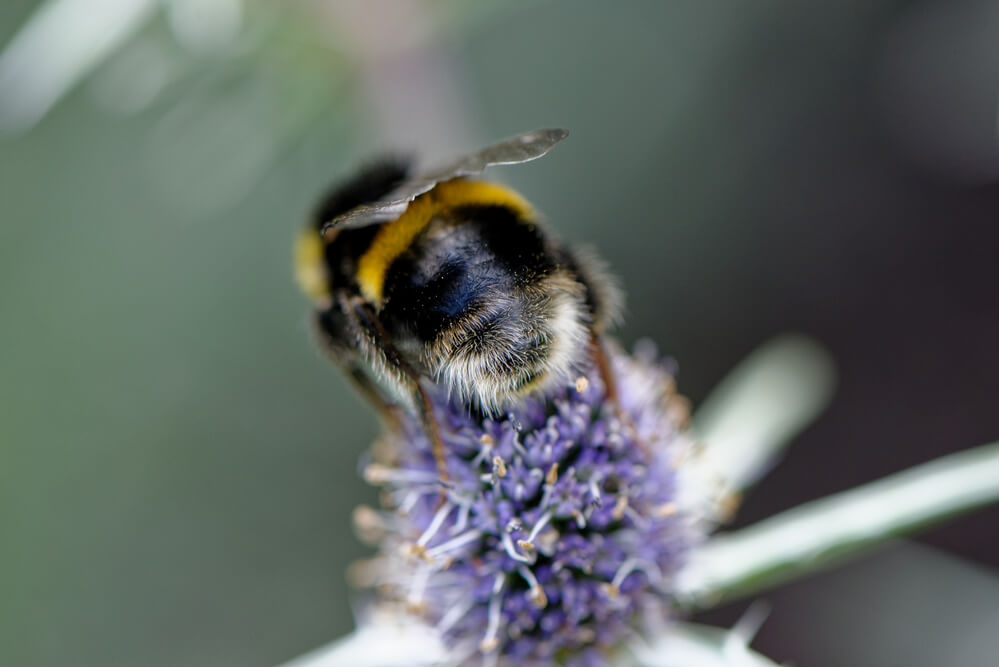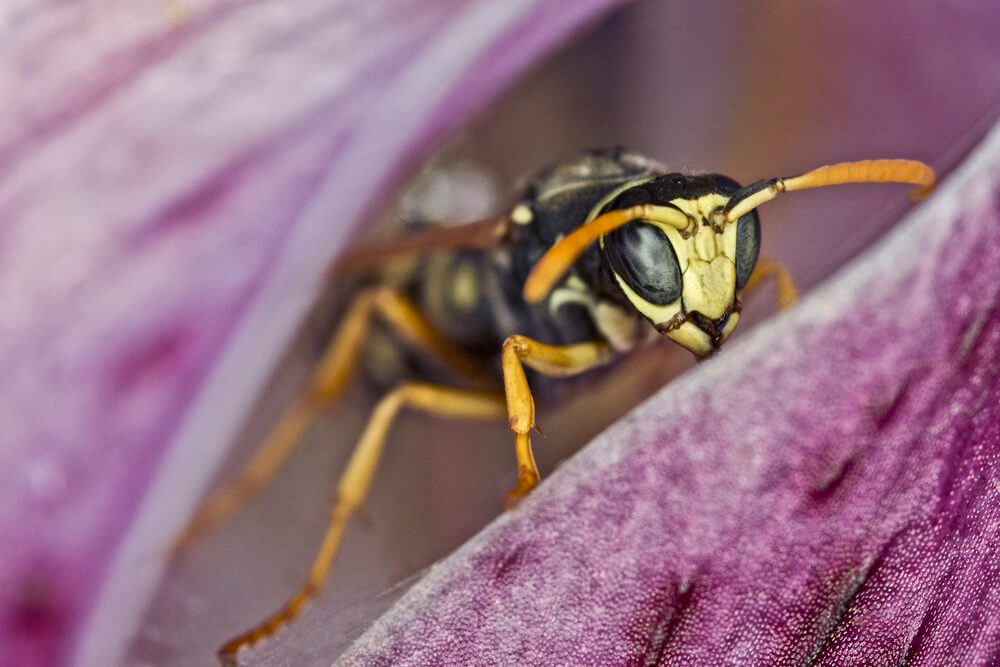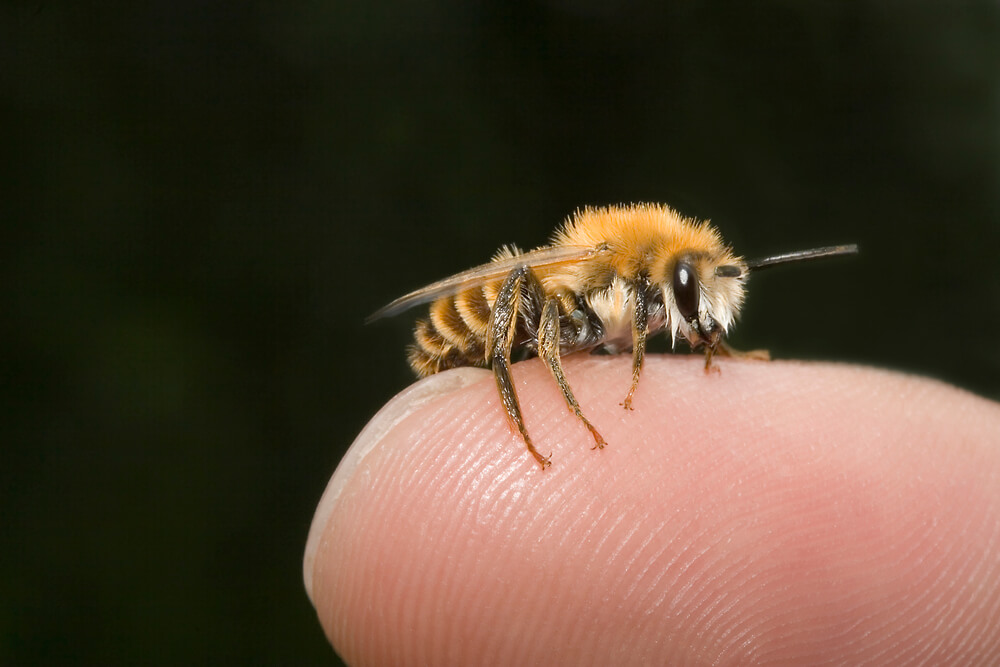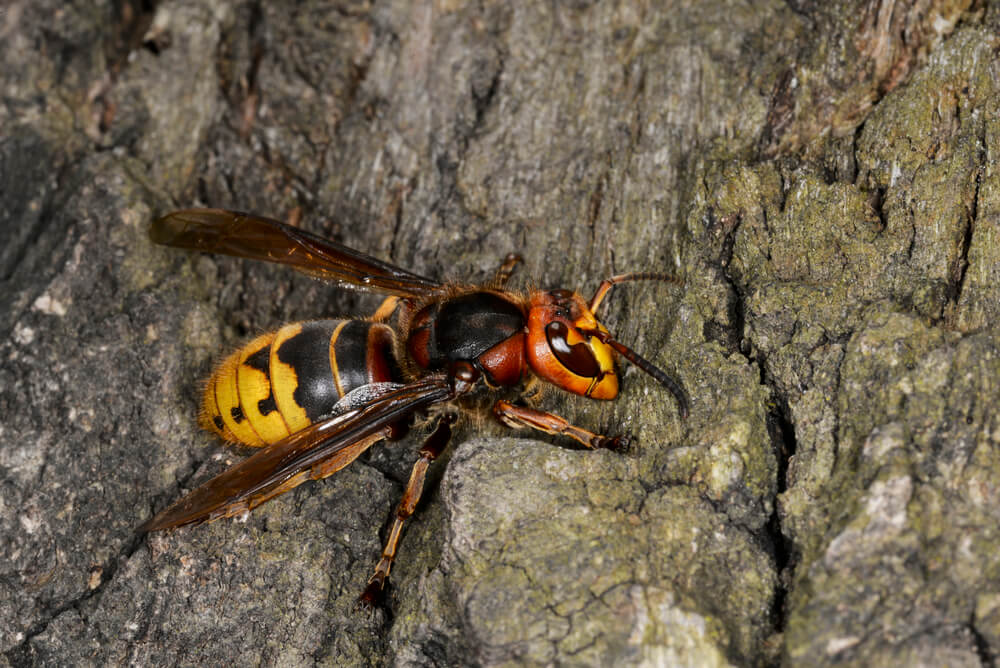Table of Contents:
What Do Bees Sound Like?
Bees have a special way of communicating with each other, just like we humans do.
But instead of using words, bees use things like wing vibrations and special dances to communicate.
With that in mind, let’s start with the most common sound:
Buzzing.
Bee Sound #1: Buzzing
Here’s a fact that might surprise you:
The buzzing sounds of bees come from the rapid beating of their wings.
Honeybees can flap their wings at a surprising 230 times per second, creating quite the buzz. Other bees, such as bumblebees, beat their wings around 130 times per second.(1, 2)
These mind-blowingly fast wing beats cause the air around the bee to vibrate, which travels to the human ear. From there, our ears interpret that vibration as a buzzing noise.
But that’s not all.
Bees buzz for other reasons too.
For example, if you’ve ever listened to a beehive, you’ll notice the buzzing gets louder if the nest is disturbed. This loud buzzing is a defense mechanism bees use to ward off potential predators.
Because let’s face it:
Bees have many predators. Take honeybees, for example.
Honeybees can produce dozens of pounds of honey per year. In turn, this makes them a prime target for honey-loving animals such as bears, honey badgers, and raccoons.
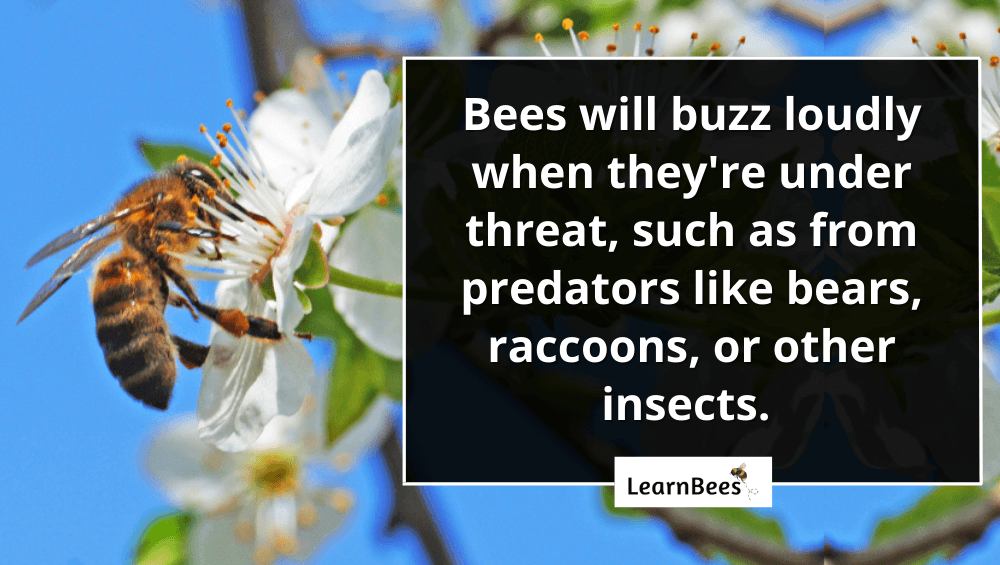
In fact, a hungry bear can destroy a honeybee hive in seconds. As a result, the bees will begin buzzing loudly to deter the bear and start stinging if the warning isn’t enough.
Better yet?
Bees will buzz loudly in other moments of stress.
For example, I was working in my flower garden one afternoon when I overheard the loud buzzing of a bumblebee. At first, I didn’t think anything of it. But as I looked closer, I realized the bumblebee was trapped in spider webbing.
She was desperately trying to work herself free, so I helped detach her from the webbing. Once free, the bumblebee’s buzzing immediately reduced, and she flew away safely.
Speaking of bumblebees, there is another type of buzzing you should know about:
Buzz pollination.
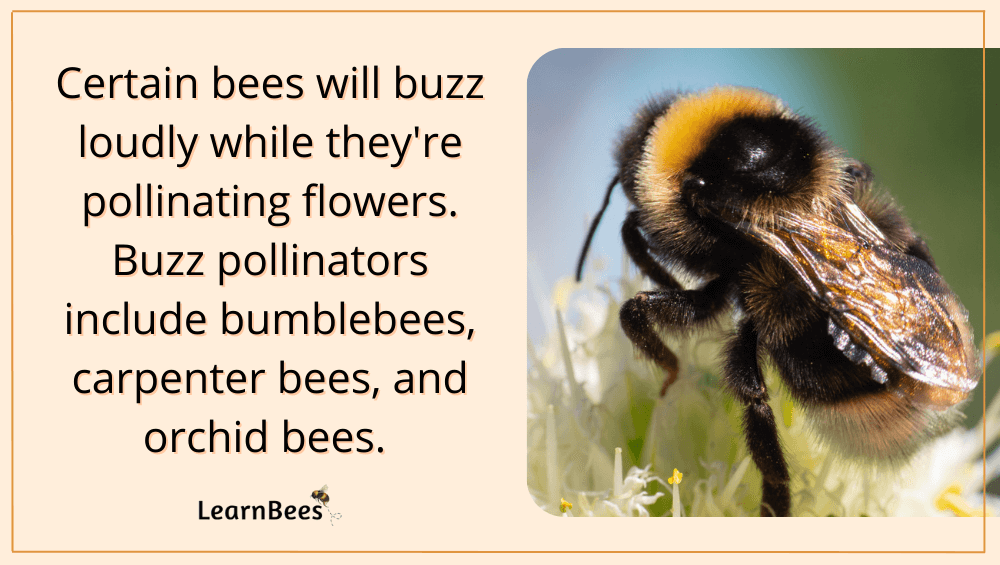
Buzz pollination is a special technique some bees use to collect pollen from flowers. It involves vibrating their wings quickly and “shaking” the pollen out of the blossom. This allows them to gather the pollen to return to their hive and eat.
And here’s the thing:
Buzz pollination is one of the most efficient ways to pollinate.
In fact, some of our main food crops require buzz pollination to produce food. For example, tomatoes, potatoes, eggplants, peppers, zucchini, blueberries, and cranberries rely on buzz pollination.
But not all bees can buzz pollinate.
For instance, honeybees are a common type of bee that cannot buzz pollinate because they don’t vibrate their wings while they’re on the flower.
Bumblebees are different because they are buzz pollinators. This means if you listen closely, you can hear the buzzing noise from a bumblebee as she “works” the flower.
Bee Sound #2: Piping
Piping is the sound made by a new honeybee queen either right before or right after she’s hatched.
Why does she do it?
Simple.
Because there can be only one queen in the hive. When multiple queens are born at the same time – as they often are – the queens will duke it out until there is only one remaining. So queens use the piping noise to locate each other in a sea of other bees.
You can think of it as a battle cry to other queens inside the colony.
Surprisingly enough:
Sometimes even the unhatched queen bees will respond to this piping noise by “quacking” in return. But this is terrible news for the unhatched queens because the new queen will end up stinging them through their cells and killing them before they even hatch.
When Do Bees Make Sounds?
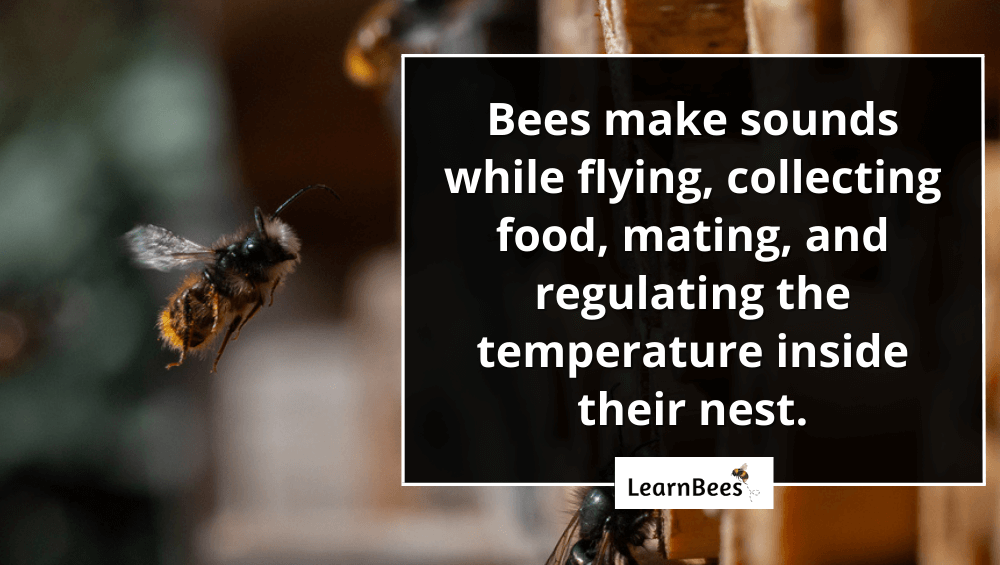
As mentioned, bees make sounds for several different reasons. The most common sound bees make is buzzing. Buzzing is the vibration of the bee’s wing muscles.
Here are a few examples of when bees buzz:
1. Bees Buzz While Flying
Bees buzz while simply flying from their nest or between flowers. This is because the bees are working hard and vibrating their wings quickly to allow them to fly.
Honeybees can fly for up to six miles, going as fast as 15 miles per hour.
2. Bees Buzz While Collecting Food
This is known as “foraging.”
Have you ever paid attention to a bee while she was on a flower?
If so, you’ve likely heard that loud buzzing noise we’re all familiar with. If many bees work beside each other in the same area, the buzzing will be even more noticeable.
That said, some bees buzz louder than others. For example, bumblebees are known for their loud buzzing noises because they’re buzz pollinators. Carpenter bees are another example of buzz pollinators.
During buzz pollination (sonification), the bee’s thorax muscles are contracted rapidly to create a vibration that shakes the pollen grains from flower anthers. This shaking process allows the bee to collect the pollen easily.
3. Bees Buzz While Mating
Some bee species buzz as a part of the mating process. For example, the mining bee (Colletes cuniculares) uses buzzing noises to attract a mate’s attention. It makes the female more receptive to the male and helps ward off potential predators.
4. Bees Buzz While Regulating the Temperature Around Them
Honeybees are the most well-studied example of this.
Honeybee colonies try to keep the temperature in the hive as close to 95 degrees as possible. So to cool the nest in hot weather, they vibrate their wings and make a misting effect with the water they bring into the nest.
In cold weather, they heat the hive by generating heat from their muscles.
5. Bees Buzz to Communicate
Bees use buzzing noises inside the hive to deter intruders, exert dominance, and communicate with the other bees.
How Do Bees Sound Compared to Wasps?
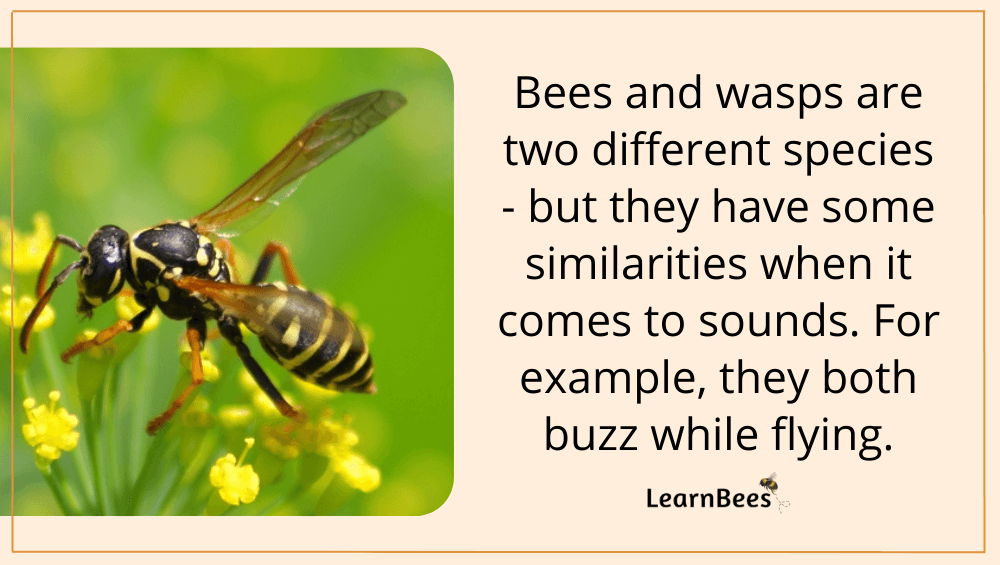
Wasps make various noises to communicate with each other and to warn other creatures. Some noises wasps make include popping, humming, and buzzing.
Remember:
There are thousands of different wasp and bee species. More importantly, wasps and bees may be related – but they’re not the same.
The most well-known bees include honeybees, carpenter bees, bumblebees, and mason bees. Well-known wasps include yellow jackets and paper wasps.
Let’s talk about the most common wasp noises:
1. Wasps Make Tapping Noises While Creating Their Nests
Like bees, wasps are either social or solitary insects.
Social wasps live together with other wasps inside a nest. Solitary wasps live alone.
Social wasps are the kind you see nesting under roof eaves. Hornets – which are a type of wasp – can have huge basketball-sized nests in trees.
Some wasps build their nest by mixing salvia with wood (called pulp) to form a paper mache-type material. The wasps often make tapping noises when adding the pulp to the nest.
This comes from the wasp’s mouths while packing down the pulp or where they’re hitting the spot where they’re adding the pulp. It’s easiest to hear the noise when the nest has dozens of wasps working on it.
2. Wasps Buzz While Flying
You can hear a wasp’s wings buzzing as it flies – especially if it’s a large wasp, like a hornet.
Similar to bees, wasps generate buzzing noises when they fly because they continuously flap their wings while in flight. Wasps can flap their wings over 100 times per second.
3. Wasp Larvae Make Popping Noises When Hungry
All wasp species share the same lifecycle, beginning as an egg and eventually transforming into an adult wasp. The wasp lifecycle includes four stages:
- Egg
- Larval
- Pupal
- Adult
Just as spring is fully coming into effect and the weather is warming up, the queen wasps will emerge from hibernation to find a spot to build a nest.
The queen starts laying eggs to build the colony as soon as possible. During this beginning stage, the queen does all the heavy lifting constructing the nest and tending to the eggs.
Once the eggs hatch, the wasp larvae need enough food to pupate and emerge as adult wasps. While the larvae are waiting to be fed, you may notice they make noises that sound like popping.
Some people even describe it as a dripping water sound.
This popping noise is the larvae mashing their mouths, signaling to the other wasps they’re ready to eat. These noises range in sound from 500 Hz to 2,500 Hz.(3)
To give you some perspective, 500 Hz is akin to an animal’s growl or rolling thunder. 2,500 Hz is considered high frequency, such as a teapot whistling.
4. Some Wasp Nests Sound Like Electric Fans
Wasps thrive in warm weather and will often reach their peak by mid-summer. This is when wasp nests will be the largest, and their buzzes can be easily heard.
With that said, some wasp nests sound more like an oscillating fan than a buzzing noise. It’s a constant thrumming noise that’s easy to distinguish.
This is partially due to how the wasp nest is built and the acoustics. Wasps build their nests out of a material that’s very thin and papery.
The paper-like texture of the nest amplifies any noise made by the wasps, which is why it sounds like an electric fan.
5. Wasps Buzz While Mating
Most creatures in the animal kingdom have their special courtship that occurs before mating. One interesting courtship ritual comes from spatuletail hummingbirds (Loddigesia mirabilis) who whip their tails back and forth to entice females.
Male wasps also have their own rituals for connecting with females. For example, some species of wasps fan their wings in a process called “wing fanning.”
When female wasps hear the wings fanning, they create buzzing noises with their wings by taking flight near the males. This encourages the males to seek out and find the females so the mating process can be complete.
6. Wasps Buzz While Swarming
You might be surprised to learn that wasps swarm just like bees do. Swarming occurs when a large number of wasps fly together in formation. This generally happens when the colony prepares to relocate to a new nesting spot.
You’ll often hear a loud buzzing noise during this time as the wasps fly together. Swarming typically lasts only a few hours before the wasps find a new place to live.
Scout wasps are tasked with finding a new nesting location. They leave scent marks behind to help recruit their fellow nestmates to the new nest.
Once the nesting spot is found, the scout wasps communicate back to the swarm and use the scent marks as a map to get back there.
The resting swarm of wasps then take off flying, which can create a loud buzzing noise thanks to their wing’s vibrations.
Meanwhile, some of the other nestmates have already started the construction of the nest. However, the wasp nest can take a week or longer to complete.
There are many reasons why wasps swarm, including:
Absconding swarm
Social wasps may swarm if their nest is threatened by predators, such as ants, or becomes damaged beyond repair due to rainstorms, high wind, or other reasons.
Emigration swarm
Wasps swarming may be related to seasonal factors in certain climates. For example, a swarm may form and move at the beginning of a wet, rainy season.
New colony creation
Like bees, wasps will swarm to a new location and build a new productive colony. This is their natural way of reproducing.
